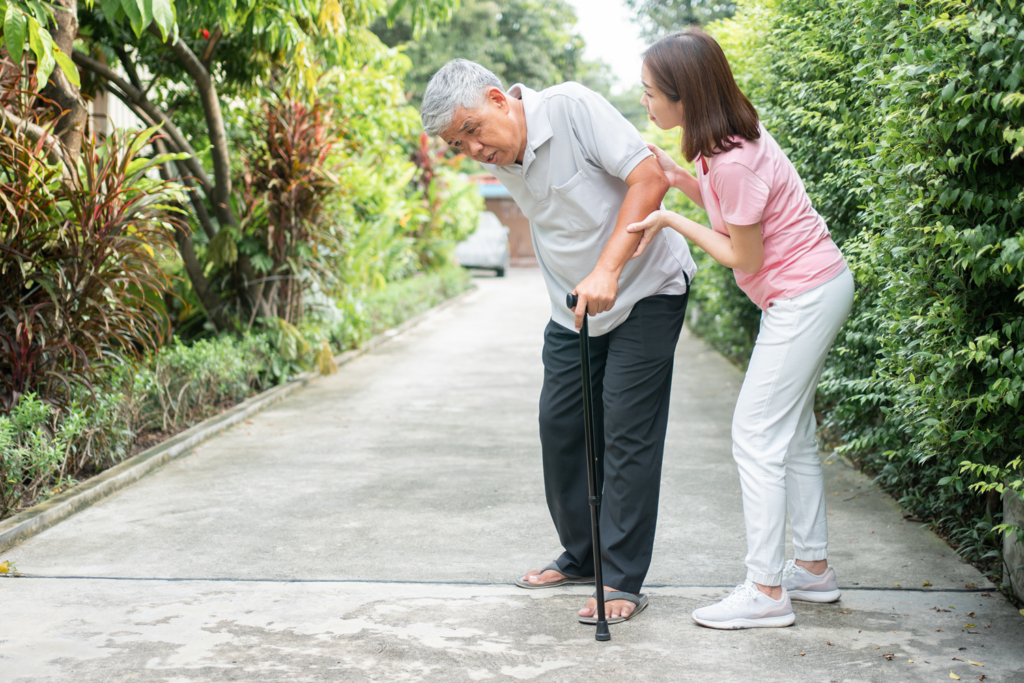Back pain is never fun. However, if you have lower back pain when walking, what’s really going on? when you know the root of the problem (such as hunching over your desk at work, poor posture, or inadequate form while working out), you can look for ways to be mindful in attempts to reduce it.
On the other hand, sometimes you can feel pain from simply walking or standing for long periods. You may think you’re doing everything right, but the discomfort remains a daily reminder that something is wrong.
What can you do to keep the pain at bay if your work duties or other responsibilities require you to walk or stand for extended time frames?

Table of Contents
ToggleLower Back Pain When Standing
Your lower back provides support and stability to your body when you’re upright. Each vertebra is separated by a jelly-filled disc that serves as a cushion. These discs can become inflamed when standing for long periods. They can also experience wear and tear with age. Standing or walking for extended periods may aggravate this inflammation, resulting in pain.
Causes of Lower Back Pain When Walking
Stress. Standing or walking for extended periods places stress on your lower back. In addition to the actual pressure on lumbar vertebrae, your back muscles may tense as well, increasing the pain if you’re standing at a high-demand job.
Being overweight. Every pound of excess weight places an additional four pounds of stress on your joints. This includes the facet joints, which are located between vertebrae. These joints allow your back to be flexible when bending down or twisting around.
Poor posture. Poor posture for a day or two won’t cause damage to your back. But do it for several years, and it will affect the anatomy of your spine: Discs, joints, muscles, ligaments, blood vessels, and nerves on your back will all experience additional stress.
Sedentary lifestyle. Inactivity leads to what’s called Disuse Syndrome. If you are used to having a sedentary lifestyle, you could inadvertently be causing the deterioration of your musculoskeletal system. As a result, you’ll experience a long list of health ailments, including chronic lower back pain.
You need to replace your mattress. Not all mattresses are created equal. If you bought yours because it was on sale on Memorial Day, without regard for what your body needs, or if you purchased it over ten years ago, it may be time to revisit that decision and look for one that takes into account your body type, weight, preferred sleeping position, or any back condition that may require additional spinal support.
Treatment for Back Pain
Treatment may vary depending on the cause of the pain. Your medical provider may suggest specific physical therapy exercises. They can teach you how to do each movement and provide a printout with instructions you can do at home. Less conservative treatment options include muscle relaxants, topical creams, or cortisone injections.
Your doctor may also analyze your gait (your form when you walk) to determine whether you have any posture issues that need to be corrected or whether wearing shoes with additional support may help reduce stress on your spine.
Prevent Lower Back Pain When Walking
You can do several things to prevent (or at least lower the likelihood of experiencing) lower back pain.
Adjust your workstation. Ergonomics are crucial in every single work industry. If your job requires you to stand at your workstation, request a height-adjustable workstation and a rubber mat. Do your part as well by opting to wear well-cushioned shoes.
Avoid wearing high heels. They may look nice; however, high heels cause your feet (and thus, the rest of your body) to stand in an unnatural position. In fact, these types of shoes alter the curves of your spine, causing uneven wear and tear on the discs between the vertebrae and the ligaments that attach muscles to your spine.
Wear orthotics. Orthotics are shoe inserts designed to provide support, proper alignment, and stability to your feet. They are beneficial if you suffer from overpronation, plantar fasciitis, or bunions.
Exercise and stretch. Always ask your doctor for specific exercise and stretch recommendations, since problems with your back may prevent you from doing certain activities.
Mind your posture. While it’s easy to become distracted with daily responsibilities, take some time to determine whether you’re standing up straight. Avoid drooping your shoulders while either standing or walking. Stand as tall as you can with your chest forward and your shoulders back, and land your body weight on your heels when walking.
Lose weight. As previously mentioned, excess weight is felt four-fold by the joints in your body. In addition, your lower back muscles must work harder to do simple tasks, such as turning around. This leads to lower back pain and knee and ankle pain, significantly affecting your quality of life and ability to keep up with friends and family.
Are You Experiencing Lower Back Pain When Walking?
Looking for a Chiropractor in Denver? Still have questions about your lower back pain when walking? Contact us! Still not sure? Read some of our 5-Star Google reviews and see what patients have to say. We’ve been helping patients in Arvada, North Denver, and Wheat Ridge, Colorado, for over 20 years. Lastly, learn more about the conditions we treat and the benefits of the many types of treatment we provide on our Health Articles page. Ready to start feeling better? Book an appointment online!

Ready for an expert opinion? Get in touch today!
With a legacy of more than 25 years, our team specializes in helping individuals triumph over back pain, neck discomfort, and persistent headaches, all without relying on addictive medications or risky surgical procedures.






